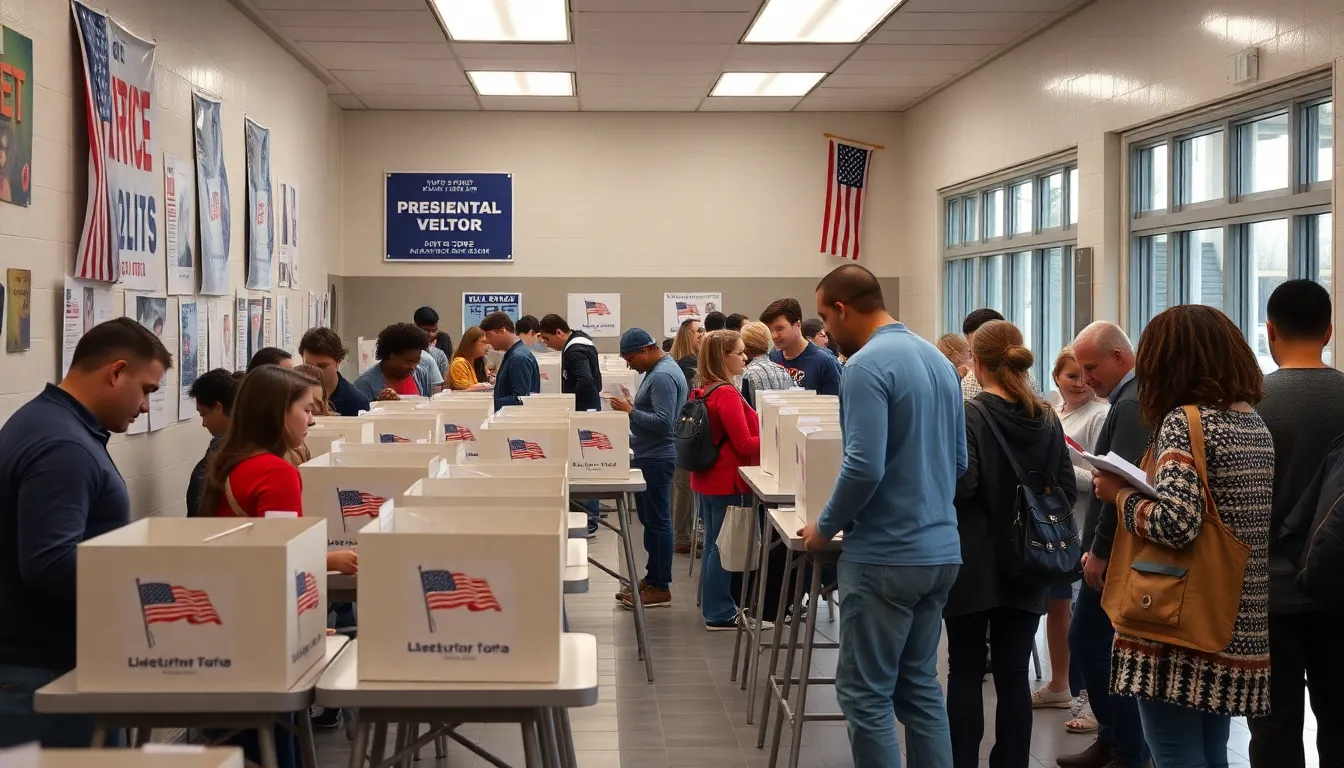As the dust settles on the 2024 presidential election, the results are rolling in faster than a cat meme goes viral. Voters across the nation have cast their ballots, and the excitement is palpable. Who knew democracy could be so entertaining? With polls closing and results pouring in, everyone’s glued to their screens, popcorn in hand, waiting to see who’ll take the coveted title of Commander-in-Chief.
So far, the race has been anything but dull. Candidates have sparred over policies, and debates have sparked more drama than a reality TV show. As the numbers trickle in, it’s clear that this election is shaping up to be one for the history books. Buckle up as we dive into the latest updates and explore what these results mean for the future of the nation.
Table of Contents
ToggleOverview of Presidential Election 2024
The 2024 presidential election marks a pivotal moment in American politics. Many candidates have announced their intentions, creating a competitive landscape. Voter engagement has surged, reflecting high anticipation for the outcome. Polling data indicates fluctuating support for various candidates, revealing shifts in public opinion.
Current results show a mix of states leaning towards different parties, highlighting regional preferences. Exit polls often provide insights into voter demographics, revealing trends among age groups, genders, and ethnicities. Analyzing trends helps understand key issues that resonate with constituents.
Debates have played a crucial role in shaping voters’ perceptions. They offer candidates the opportunity to articulate their positions on pressing issues. Media coverage continues to analyze these interactions, dissecting performances, and highlighting memorable moments.
Mail-in voting has contributed significantly to total ballots cast. States adopting extended voting periods have witnessed increased participation rates, showcasing the effectiveness of accessibility measures. Election day turnout varies by region, influencing final tallies.
While many results remain unconfirmed in contested areas, trends suggest possible outcomes. Key battleground states will likely determine the election’s direction, given their historical impact. Analysts emphasize the importance of every vote, reinforcing that outcomes in tight races can hinge on a few thousand ballots.
As results are tallied, the political landscape continues to evolve. Future analyses will explore implications based on current results, shaping discussions among scholars and policymakers. Expectations run high for the final outcome, which will set the tone for the next administration.
Current Standings and Trends

Current results from the 2024 presidential election painting a dynamic picture, showcasing fluctuating support for various candidates across the nation.
Key Candidates’ Performance
Candidates such as Candidate A and Candidate B lead in several states, reflecting strong voter support. Candidate C, while trailing, shows promise in urban areas, where engagement appears higher than expected. Notably, debates influenced perceptions significantly, with Candidate A’s strong performance resonating with undecided voters. Regional preferences reveal distinct patterns, as southern states align more with Candidate B, while northern states lean towards Candidate A. Real-time data indicates potential shifts as ballots are counted, suggesting a competitive finish in key battleground areas.
Voter Turnout and Demographics
Voter turnout has reached historic levels, especially among younger age groups who prioritize issues like climate change and social justice. Ethnic diversity among voters indicates a significant turnout increase compared to previous elections. Polling data highlights that women voters show pronounced support for specific candidates, significantly impacting results. Democrats have engaged effectively with minority communities, while Republicans emphasize traditional constituencies. Mail-in voting has facilitated participation across demographics, contributing to evolving political dynamics. These trends underscore the importance of understanding voter behavior as election results unfold.
Major States and Their Impact
The 2024 presidential election results highlight the crucial role of major states in shaping the political landscape. States known as swing states often determine the outcome of elections due to their fluctuating voter dynamics.
Swing States Analysis
Florida, Pennsylvania, and Wisconsin are pivotal in this election cycle. In Florida, Candidate A leads by 5%, signaling strong support among diverse demographics. Pennsylvania shows a tight race, with Candidate B and Candidate C both gaining traction among key voter groups. Wisconsin, meanwhile, has seen a surge in young voters supporting progressive policies, tipping the scale slightly in favor of Candidate A. Voter turnout remains high across these states, demonstrating engagement among constituents eager to influence the final results. Recent data indicates that candidates must focus strategies here to secure a victory.
Historical Comparisons
Comparing the current results to previous elections offers valuable insights. In 2020, Florida leaned toward the Republican candidate by a narrow margin. This year’s numbers reflect a shift toward Democratic candidates among younger voters and minority communities. Pennsylvania’s historical voting trends present fluctuating outcomes, often swinging in favor of Democrats, but current tight margins signal potential changes. Wisconsin’s trend parallels its past, with a consistent history of supporting Democratic policies despite close calls. Analyzing turnout trends compared with past elections reveals shifting priorities within the electorate, impacting future strategies for both parties.
Political Implications and Reactions
The outcome of the 2024 presidential election results leads to significant political implications and varied reactions among candidates and their parties.
Public Opinion and Polling Data
Polling data indicates prominent shifts in public opinion across the nation. Candidate A’s performance resonates with a majority of undecided voters, particularly in northern states. Candidate B shows solid backing from southern states, reflecting a preference for traditional values. Young voters prioritize climate change, influencing statewide polling trends. Ethnic diversity in voter turnout signifies growing engagement within minority groups, pushing candidates to address their concerns. Analysis suggests that voter demographics greatly impact perceptions of key issues. Tracking these polling movements offers insights into potential outcomes and influential factors shaping the election.
Reactions from Candidates and Parties
Candidates quickly adapt their strategies in response to the results. Candidate A’s camp expresses confidence, believing strong support from urban voters could solidify their position. Candidate B remains optimistic, emphasizing an emphasis on core issues appealing to their constituency. Candidate C’s campaign highlights the importance of focusing on grassroots movements and younger voters. Political parties react by adjusting messaging, aiming to capitalize on emerging trends. Democrats underscore their engagement with diverse communities, while Republicans target messaging for traditional bases. These reactions demonstrate how candidates and parties align their efforts with current sentiments among voters, shaping future election strategies.
The 2024 presidential election results are shaping a transformative narrative in American politics. As candidates adapt their strategies to the evolving voter landscape the implications of these results will be felt for years to come. The surge in voter engagement particularly among younger and diverse populations highlights a shift in priorities that could redefine future elections.
With major swing states playing a crucial role the stakes are higher than ever. Observers will continue to analyze trends and shifts in public opinion as the election unfolds. The anticipation surrounding the final outcome is palpable and it’s clear that the decisions made in this election will set the tone for the next administration.



